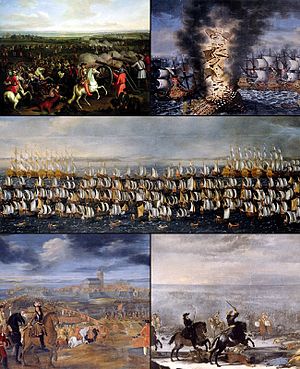Gyldenløve War
| Scanian War | |||||||||
|---|---|---|---|---|---|---|---|---|---|
| Part of the Franco-Dutch War | |||||||||
 Clockwise from top: Battle of Fehrbellin, Battle of Öland, Danish invasion fleet, Siege of Landskrona, Battle of Lund |
|||||||||
|
|||||||||
| Belligerents | |||||||||
|
|
|
||||||||
| Commanders and leaders | |||||||||
|
|
|
||||||||
The Scanian War (Danish: Skånske krig, Swedish: Skånska kriget, German: Schonischer Krieg) was a part of the Northern Wars involving the union of Denmark–Norway, Brandenburg and Sweden. It was fought from 1675 to 1679 mainly on Scanian soil, in the former Danish provinces along the border with Sweden and in Northern Germany. While the latter battles are regarded as a theater of the Scanian war in English, Danish and Swedish historiography, they are seen as a separate war in German historiography, called the Swedish-Brandenburgian War (German: Schwedisch-Brandenburgischer Krieg).
The war was prompted by Swedish involvement in the Franco-Dutch War. Sweden had allied with France against several European countries. The United Provinces, under attack by France, sought support from Denmark–Norway. After some hesitation, King Christian V started the invasion of Skåneland (Scania) in 1675, while the Swedish were occupied with a war against Brandenburg. The invasion of Scania was combined with a simultaneous Norwegian front called the Gyldenløve War, forcing the defending Swedes to fight a two-front war in addition to their entanglements in the Holy Roman Empire.
The Danish objective was to retrieve the Scanian lands that had been ceded to Sweden in the Treaty of Roskilde, after the Northern Wars. Although the Danish offensive was initially a great success, Swedish counter-offensives led by the 19-year-old Charles XI of Sweden nullified much of the gain.
...
Wikipedia
